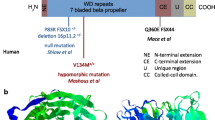Abstract
Wiskott-Aldrich syndrome (WAS) is an X-linked immunodeficiency disorder associated with lymphocytes and platelet abnormalities. The gene that encodes the Wiskott-Aldrich protein (WASP) was recently isolated, and shown to be defective in WAS patients. WASP contains multiple domains that interact with various signalling proteins, including the guanine triphosphatase (GTPase) Cdc42Hs and SH3 domain-containing proteins. Biochemical and genetic evidence strongly suggests that WASP is an important protein in the regulation of cell morphology. Recent progress in the identification of molecular partners for WASP suggests a molecular mechanism for the cellular abnormalities of WAS.
Similar content being viewed by others
Author information
Authors and Affiliations
Additional information
Received 17 April 1998; received after revision 2 June 1998; accepted 2 June 1998
Rights and permissions
About this article
Cite this article
Abo, A. Understanding the molecular basis of Wiskott-Aldrich syndrome. CMLS, Cell. Mol. Life Sci. 54, 1145–1153 (1998). https://doi.org/10.1007/s000180050242
Published:
Issue Date:
DOI: https://doi.org/10.1007/s000180050242




